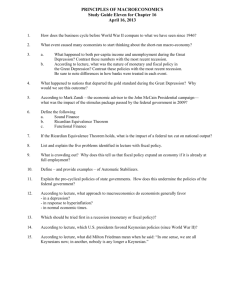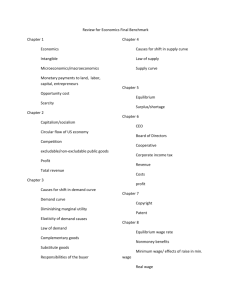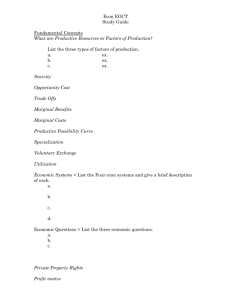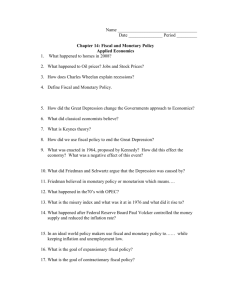Anatomy of the Financial Crisis, with comments on Acemoglu
advertisement
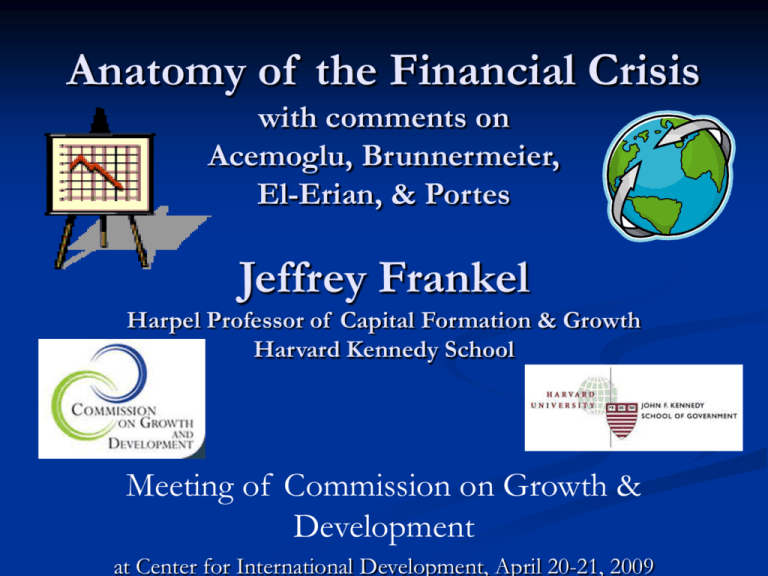
Anatomy of the Financial Crisis with comments on Acemoglu, Brunnermeier, El-Erian, & Portes Jeffrey Frankel Harpel Professor of Capital Formation & Growth Harvard Kennedy School Meeting of Commission on Growth & Development at Center for International Development, April 20-21, 2009 Six root causes of financial crisis 1. US corporate governance falls short E.g., rating agencies; executive compensation options; golden parachutes… MSN Money & Forbes 2. US households save too little, borrow too much. 3. Politicians slant excessively toward homeownership Tax-deductible mortgage interest, cap.gains; FannieMae & Freddie Mac; Allowing teasers, NINJA loans, liar loans… 2 Six root causes of financial crisis, cont. 4. Starting 2001, the federal budget was set on a reckless path, reminiscent of 1981-1990 5. Monetary policy was too loose during 2004-05, accommodating fiscal expansion, reminiscent of the Vietnam era. 6. Financial market participants during this period grossly underpriced risk risks: housing crash, $ crash, oil prices, geopolitics…. 3 Current account imbalances Richard Portes: “Global Imbalances caused crisis.” I disagree. I view low US National Saving as main source of CA. I agree with Richard this crisis is not the feared US sudden stop => low volatility and interest rates => leverage. That’s the next crisis. But then why interest rates low? Easy money. Many disagree (My “9 Reasons…” for Growth Commission) Global savings glut hypothesis (Bernanke…) But measured world saving did not rise in this decade. Bretton Woods II (Dooley, Garber…) . (Like 1960s.) But BW I operated for only 14 years. We’re near the end. US offers the high-quality assets. (Forbes, Gourinchas, Caballero..) Not really. Was clear in 2001 (Enron…) 4 But I would think herd mentality – the opposite of heterogeneous views -- would be the bigger problem. Yes. Note: time-varying variance itself gives fat tails. Yes. We thought securitization of mortgages would “spread the risk.” But it 5 spread risk like a virus ! I would like to suggest a fourth “new” idea in volatility: When using Black-Scholes or other formulas to price options (VIX) or bond spreads (corporate bonds), analysts simply plug in variance estimated from the recent past. During 2004-2006, lagged variance was low, tho forward-looking risk was high. 6 As Adrian & Brunnermeier point out (p.5), “After a string of good news, risk seems tamed, but, when a new tail event occurs, the estimated risk measure may sharply increase. This problem is most pronounced if the data samples are short. Hence, regulatory requirements that are naively based on estimated risk measures would be stringent during a crisis and lax during a boom. This introduces procyclicality – exactly the opposite of the goal of effective regulation.” I couldn’t agree more. But: (i) Does this require that tail events are asymmetrically negative? (ii) If so, could the causality run from a variance innovation, via the risk premium, to a fall in asset prices, instead of the other way? 7 Origins of the financial/economic crises Monetary policy easy 2004-05 Stock market bubble Underestimated risk in financial mkts Failures of corporate governance saving too little, borrowing too Homeownership bias much Excessive leverage in financial institutions Predatory lending Excessive complexity MBS s CDSs China’s growth Stock market crash Gulf instability CDO s Financial crisis 2007-08 Oil price spike 2007-08 Households Recession 2008-09 Federal budget deficits Low national saving Housin g bubble Foreig n debt Housin g crash Lower longterm econ.growth Eventual loss of US hegemony 8 The return of Keynes Keynesian truths abound today: Origins of the crisis The Liquidity Trap Fiscal response Motivation for macroeconomic intervention: to save market microeconomics International transmission Need for macroeconomic coordination 9 The origin of the crisis was an asset bubble collapse, loss of confidence, credit crunch…. like Keynes’ animal spirits or beauty contest . Add in von Hayek’s credit cycle, Kindleberger ’s “manias & panics” the “Minsky moment,” & Fisher’s “debt deflation.” 78 It was not a monetary contraction in response to inflation as were 1980-82 or 1991. But, rather, a credit cycle: 2003-04 monetary expansion showed up only in asset prices. (Borio of BIS.) 10 Financial regulation Good for Daron ! True. But if we don’t draw up an informed list, politicians will come up with a worse one. 11 Desirable longer-term financial reforms Executive compensation Securities Regulatory agencies: In US, merge SEC & CFTC? Create a central clearing house for CDSs . Credit ratings: Compensation committee not under CEO. Maybe need Chairman of Board. Discourage golden parachutes & options, unless truly tied to performance. Reduce reliance on ratings. AAA does not mean no risk. Reduce ratings agencies’ conflicts of interest. Lending Mortgages Banks: Consumer protection, incl. standards for mortgage brokers Fix “originate to distribute” model, so lenders stay on the hook. Regulators shouldn’t let banks use their own risk models (VAR); should make capital requirements less pro-cyclical . Extend bank-like regulation to “near banks.” Heavy overlap with Richard Portes’ list, FT, 11/11/08 12 I always thought CoVar stood for Covariance. But that is no more – nor less – confusing than VAR standing for Value at Risk instead of either Variance or Vector AutoRegression. In fact CoVaRiance rather captures the spirit of the idea. Adrian & Brunnermeier make the sensible point that regulators should worry about how much a bank contributes to systemic risk (CoVaR), more than just own risk (VaR). Analogous to a CAPM for regulators. 13 Lehman Brothers, whose failure inflicted maximum adverse effect on the financial system in Sept. 2008, shows up with almost the highest risk rating by CoVaR, but also by VaR. 14 I would phrase it: We have learned something we should have already known -financial markets need a lot of regulation, but market capitalism still works best in the real economy. 15 Motivation for macroeconomic intervention The view that Keynes stood for big government is not really right. He wanted to save market microeconomics from central planning, which had allure in the 30s & 40s. Remember, Bretton Woods blessed capital controls and free trade. Some on the Left today reacted to the crisis & election by hoping a new New Deal would overhaul the economy. My view: faith in the unfettered capitalist system has been shaken with respect to financial markets, true; but not with respect to the rest of the economy; Obama’s economics are centrist, not far left. 16 International transmission remains as powerful as ever (no “de-coupling”) Consistent with old-fashioned Keynes-MeadeMundell-Fleming transmission via trade balances. 17 International coordination of fiscal expansion? As in the classic Locomotive Theory Theory: in the Nash non-cooperative equilibrium each country holds back from fiscal expansion for fear of adverse trade deficits. Solution: A bargain where all expand together. In practice: example of Bonn Summit, 1978 didn’t turn out so well, primarily because inflation turned out to be a bigger problem than realized (& the German world was non-Keynesian). Inflation is less a problem this time. The Germans are the same. 18 Multilateral initiatives Hold the line against protectionism Attempts at multilateral reform More inclusion of developing countries Locus shifted from G7 to G20 at London meeting (April). The IMF and World Bank Regulatory reform. Reallocation of shares Break US-EU duopoly on MD & President Tripling of size of IMF, incl. new SDR issue (a la Keynes) Reduce procyclical Basel capital requirements; FSF; …. Coordinated expansion? Failed at London G-20. As had cooperation in 1933 (London Monetary & Economic Conference) 19 US fiscal stimulus looks the largest of the G-10. But most others have larger automatic stabilizers than the US 20 Mohamed El-Elrian & Mike Spence, “Essential Task for G20 Leaders is a Cinema Trip to See A Beautiful Mind” The Daily Telegraph, March 30, 2009 Apparently Mohamed and Mike think the producers of that movie took the opportunity to teach the audience the simple principle of the prisoner’s dilemma. A reasonable inference. But that’s not how I remember the movie. Hollywood doubts the analytical aptitude/interests of the public.21 22 Appendices Origins of the crisis The US recession Transmission to rest of world Global forecast The US policy response Global current account imbalances Monetary easing Financial repair Fiscal expansion Implications of the crisis for the status of the dollar Adjustment in surplus countries End of the 3rd emerging markets capital boom 23 Origins of the crisis Well before 2007, there were danger signals in US: Real interest rates <0 , 2003-04 ; Early corporate scandals (Enron…); Risk was priced very low, housing prices very high, National Saving very low, current account deficit big, leverage high, mortgages imprudent… 24 US real interest rate < 0, 2003-04 Source: Benn Steil, CFR, March 2009 25 Onset of the crisis Initial reaction to troubles: Reassurance in mid-2007: “The subprime mortgage crisis is contained.” It wasn’t. Then, “The crisis is in Wall Street, sparing Main Street.” It didn’t. Then de-coupling : “The US turmoil will have less effect on the rest of the world than in the past.” It hasn’t. By now it is clear that the crisis is the worst in 75 years, and is as bad abroad as in the US. 26 US Recession In December 2008, NBER Business Cycle Dating Committee proclaimed US recession had started in December 2007. As of March 2009, the recession’s length ties the postwar record of 1981-82 (16 months). Recovery unlikely before late 2009 => recession is already longest since 1930s. Likely also to be as severe as oil-shock recessions of 1974 and 1980-82. 27 BUSINESS CYCLE REFERENCE DATES Peak Trough Quarterly dates are in parentheses August 1929 (III) May 1937 (II) February 1945 (I) November 1948 (IV) July 1953 (II) August 1957 (III) April 1960 (II) December 1969 (IV) November 1973 (IV) January 1980 (I) July 1981 (III) July 1990 (III) March 2001 (I) December 2007 (IV) Average, all cycles: 1854-2001 March 1933 (I) June 1938 (II) October 1945 (IV) October 1949 (IV) May 1954 (II) April 1958 (II) February 1961 (I) November 1970 (IV) March 1975 (I) July 1980 (III) November 1982 (IV) March 1991 (I) November 2001 (IV) (32 cycles) 1945-2001 (10 cycles) Source: NBER Contraction Peak to Trough 43 13 8 11 10 8 10 11 16 6 16 8 8 17 10 28 US employment peaked in Dec. 2007, which is the most important reason why the NBER BCDC dated the peak from that month. Since then, 5 million jobs have been lost (4/3/09). employment Source: Bureau of Labor Statistics PayrollPayroll employment series series Source: Bureau of Labor Statistics 29 My favorite monthly indicator: total hours worked in the economy It confirms: US recession turned severe in September, when the worst of the financial crisis hit (Lehman bankruptcy…) 30 The US recession so far is deep compared to past and to others’ Source: IMF, WEO, April 2009 31 Recession was soon transmitted to rest of world: Contagion: Falling securities markets & contracting credit. Especially in those countries with weak fundamentals: Iceland, Hungary & Ukraine… Or oil-exporters that relied heavily on high oil prices: Russia… But even where fundamentals relatively strong: Korea, Brazil… Some others experiencing their own housing crashes: Ireland, Spain… Recession in big countries was soon transmitted to all trading partners through loss of exports. 32 International Trade has Plummeted Source: OECD 33 The recession has hit more countries than any in 60 years 34 Forecasts 35 Interim forecast OECD 3/13/09 Forecast for 2009 = -3½% 36 “World Recession” No generally accepted definition. A sharp fall in China’s growth from 11% is a recession. Usually global growth < 2 % is considered a recession. The World Bank now (March) forecasts negative global growth in 2009, for the first time in 60 years. 37 Unemployment rates are rising everywhere 38 Do we know this won’t be another Great Depression? One hopes we won’t repeat the mistakes of the 1930s. Monetary response: good this time Financial regulation: we already have bank regulation to prevent runs. But it is clearly not enough. Fiscal response: OK, but : constrained by inherited debt. Also Europe was unwilling to match our fiscal stimulus at G-20 summit. Trade policy: Let’s not repeat Smoot-Hawley ! E.g., the Buy America provision Mexican trucks 39 The Fed certainly hasn’t repeated the mistake of 1930s: letting M1 fall. 2008-09 1930s Source: IMF, WEO, April 2009 Box 3.1 40 U.S. Policy Responses Monetary easing is unprecedented, appropriately. But it has largely run its course: Policy The (graph) famous liquidity trip is not mythical after all. As Krugman & others warned us re Japan in 90s. & lending, even inter-bank, builds in big spreads interest rates ≈ 0. since mid-2007, not just since September 2008. (graph) Now aggressive quantitative easing, as the Fed continues to purchase assets not previously dreamt of. 41 Source: OECD Major central banks have cut interest rates sharply. 42 Bank spreads rose sharply when sub-prime mortgage crisis hit (Aug. 2007) and up again when Lehman crisis hit (Sept. 2008). Source: OECD, Datastream 43 Corporate spreads between corporate & government benchmark bonds zoomed after Sept. 2008 US € 44 Policy Responses, continued Obama policy of “financial repair”: Infusion of funds has been more conditional, vs. Bush Administration’s no-strings-attached. Some money goes to reduce foreclosures. Conditions imposed on banks that want help: (1) no-dividends rule, (2) curbs on executive pay, (3) no takeovers, unless at request of authorities & (4) more reporting of how funds are used. But so far they have avoided “nationalization” of banks45 Policy Responses -- Financial Repair, cont. Secretary Geithner announced PPIP 3/23/09: Public-Private Partnership Investment Program When buying “toxic” or “legacy assets” from banks, their prices are to be set by private bidding (from private equity, hedge funds, and others), rather than by an overworked Treasury official pulling a number out of the air and risking that taxpayers grossly overpay for the assets, as under TARP. 46 Policy Responses -- Financial Repair, cont. How much money is the government putting into the PPIP? designed to be enough to attract participants, but not more. From the Treasury (already set aside under TARP), leveraged courtesy of FDIC & Fed. Taxpayers share equally with new private investors in upside, but admittedly bear all the downside risk. Nationalization could have been a lot more expensive. 47 The PPIP was attacked from both sides in part due to anger over AIG bonuses, etc. FT, Mar 25, 2009 But the stock market reacted very positively, and some respected commentators are supportive. 48 Policy Responses, Unprecedented continued US fiscal expansion. Obama proposed an $825 expansion Version passed by Congress was just a bit worse. Good old-fashioned Keynesian stimulus Even the belief that spending provides more stimulus than tax cuts has returned; not just from Larry Summers, for example, but also from Martin Feldstein. 49 Fiscal response “Timely, targeted and temporary.” American Recovery & Reinvestment Plan includes: Aid to states: education, Medicaid…; Other spending. Unemployment benefits, food stamps, especially infrastructure, and Computerizing medical records, smarter electricity distribution grids, and high-speed Internet access. 50 Fiscal stimulus also included Tax cuts for lower-income workers (“Making Work Pay”) EITC, child tax credit. Fix for the AMT (for the middle class). But soon will need to return toward fiscal discipline Let Bush’s pro-capital tax cuts expire in 2011. Economists want to substitute energy taxes for others. 51 The next crisis The twin deficits: US budget deficit => current account deficit Until now, global investors have happily financed US deficits. The recent flight to quality paradoxically benefited the $, even though the international financial crisis originated in the US. For now, US TBills are still viewed as the most liquid & riskless. Sustainable? How long will foreigners keep adding to their $ holdings? The US can no longer necessarily rely on support of foreign central banks, either economically or politically. 52 The 2007-08 financial crisis has probably further undermined US monetary hegemony in the long run US financial institutions have lost credibility Expansionary fiscal and monetary policy may show up as $ depreciation in the long run. The long slow decline of the $ as an international reserve currency may accelerate. 53 Simulation of central banks’ of reserve currency holdings Scenario: accession countries join EMU in 2010. (UK stays out), but 20% of London turnover counts toward Euro financial depth, and currencies depreciate at the average 20-year rates up to 2007. From Chinn & Frankel (Int.Fin., 2008) .8 Simulation predicts € may overtake $ as early as 2015 .7 USD .6 EUR forecast .5 USD forecast .4 .3 DEM/EUR .2 Tipping point in updated simulation: 2015 .1 .0 54 1980 1990 2000 2010 2020 2030 54 2040 The 2001-2020 decline in international currency status for the $ would be only one small part of a loss of power on the part of the US. But: A loss of $’s role as #1 reserve currency could in itself have geopolitical implications. Historical precedent: £ (1914-1956) With a lag after US-UK reversal of ec. size & net debt, $ passed £ as #1 international currency. “Imperial over-reach:” the British Empire’s widening budget deficits and overly ambitious 55 Precedent: The Suez crisis of 1956 is often recalled as the occasion on which Britain was forced under US pressure to abandon its remaining imperial designs. But recall also the important role played by a simultaneous run on the £ and the American decision not to help the beleaguered currency. [i] [i] Frankel, “Could the Twin Deficits Jeopardize US Hegemony,” Journal of Policy Modeling, 28, no. 6, Sept. 2006. At http://ksghome.harvard.edu/~jfrankel/SalvatoreDeficitsHegemonJan26Jul+.pdf . Also “The Flubbed Opportunity for the US to Exercise Global Economic Leadership”; in The International Economy, XVIII, no. 2, Spring 2004 at http://ksghome.harvard.edu/~jfrankel/FlubJ23M2004-.pdf 56 56 “Be careful what you wish for!” US politicians have not yet learned how dependent on Chinese financing we have become. 57 In the short run, however, the financial crisis has caused a flight to quality which apparently still means a flight to US$. US Treasury bills are more in demand than ever, as reflected in very low interest rates. The $ appreciated in 2008, rather than depreciating as the “hard landing” scenario had predicted. => The day of reckoning had not yet arrived. Recent Chinese warnings may be a turning point: Premier Wen worried US T bills will lose value. PBoC Gov. Zhou proposed replacing $ as international currency. 58 Global Current Account Imbalances may now be forced to adjust US deficit will likely diminish, though adjustment requires $ depreciation. Who must take corresponding reduction in current account surpluses? Europe says: “Not us. Overall we are in balance.” Others say: Europe can expect to take a share, roughly proportionate to its share in world trade, IMF seems to think oil exporters will take all adjustment (see graph) 59 Current account adjustment: US vis-á-vis oil exporters (as % of GWP; source: IMF) 60 The OECD sees the €-area bearing much of the adjustment. Source: OECD Economic Outlook, Nov. 2008. 3/ as % of GDP 61 But emerging markets now have to spend some hard-earned reserves 62 3 cycles of net private capital flows to emerging markets, by region peaking in 1982, 1997 and 2008 Source: Capital Flows to Emerging Market Economies, IIF, 1/27/09. 63 Capital flows to emerging markets peaked in 2007 from: EM Fund Flows, Citi, December 200864 Source: Benn Steil, Lessons of the Financial Crisis, CFR, Marc 65 BRIC growth has disappeared 66 Jeffrey Frankel James W. Harpel Professor of Capital Formation & Growth Harvard Kennedy School http://ksghome.harvard.edu/~jfrankel/index.htm Blog: http://content.ksg.harvard.edu/blog/jeff_frankels_weblog/

